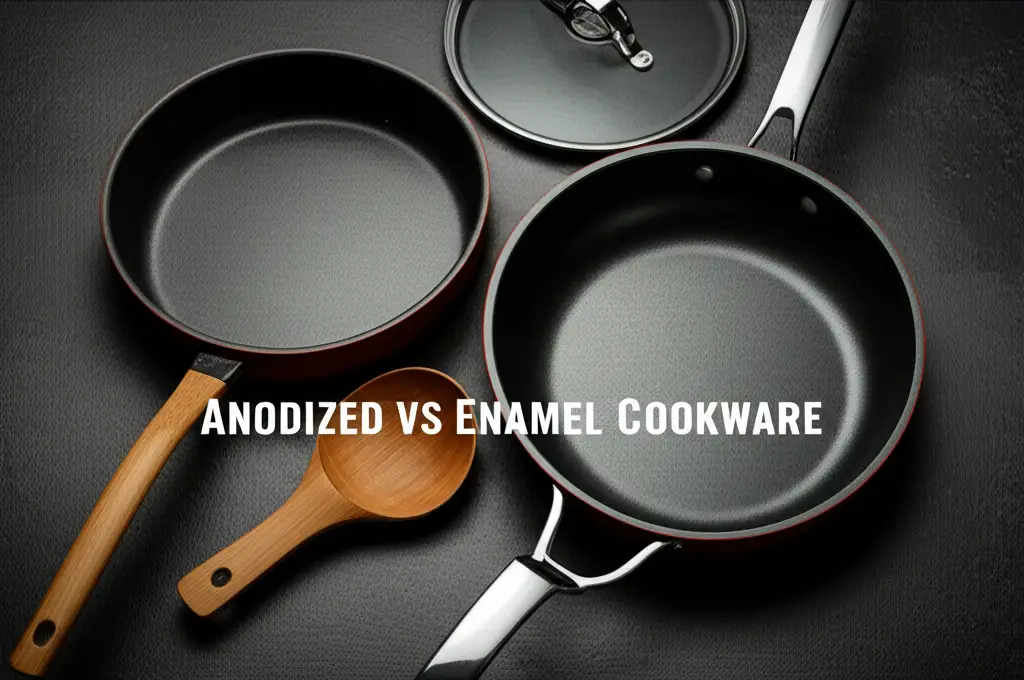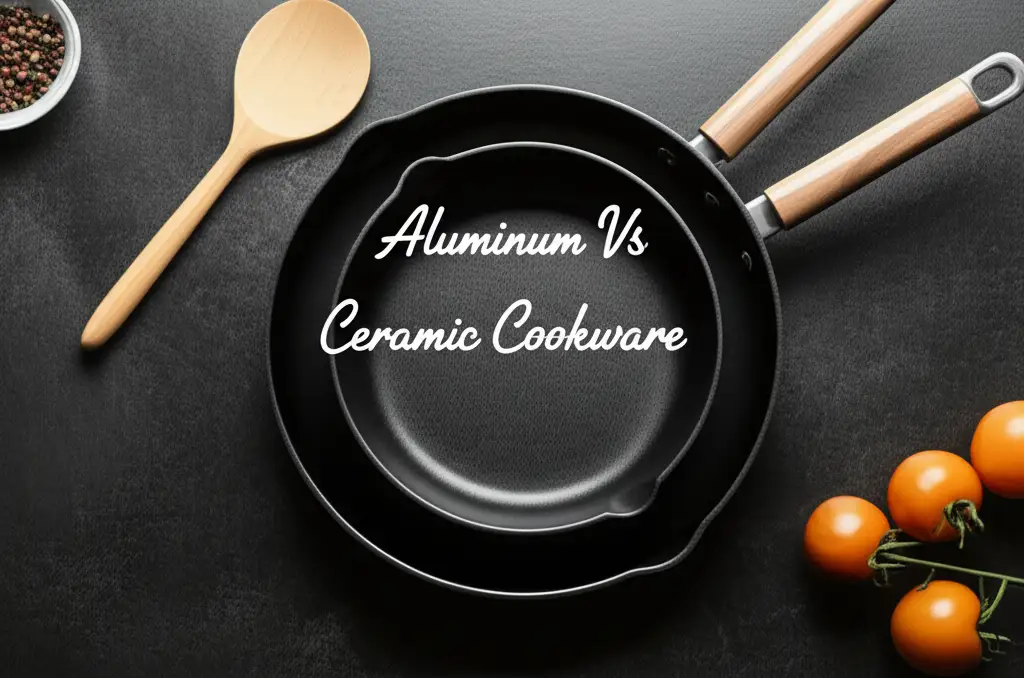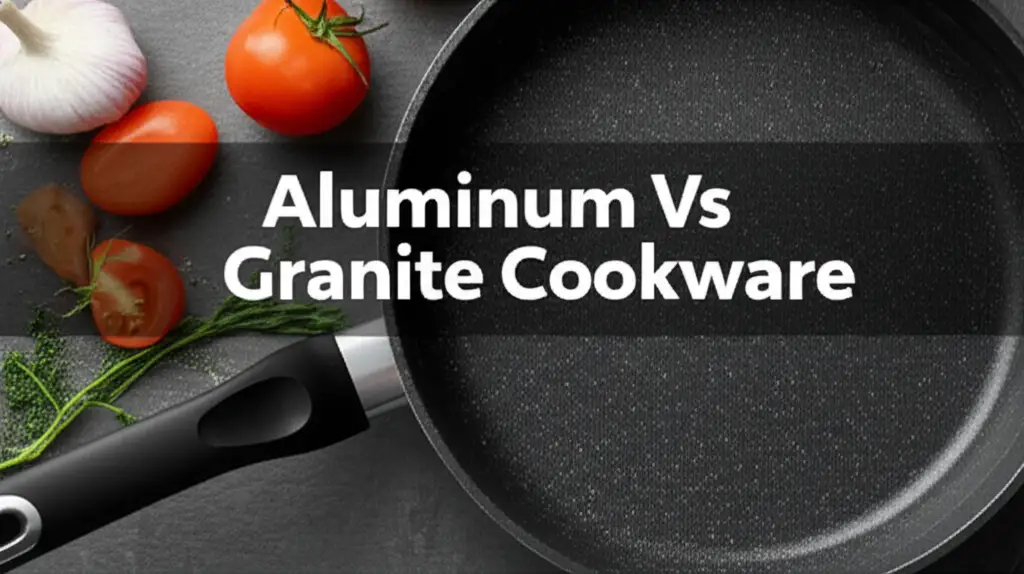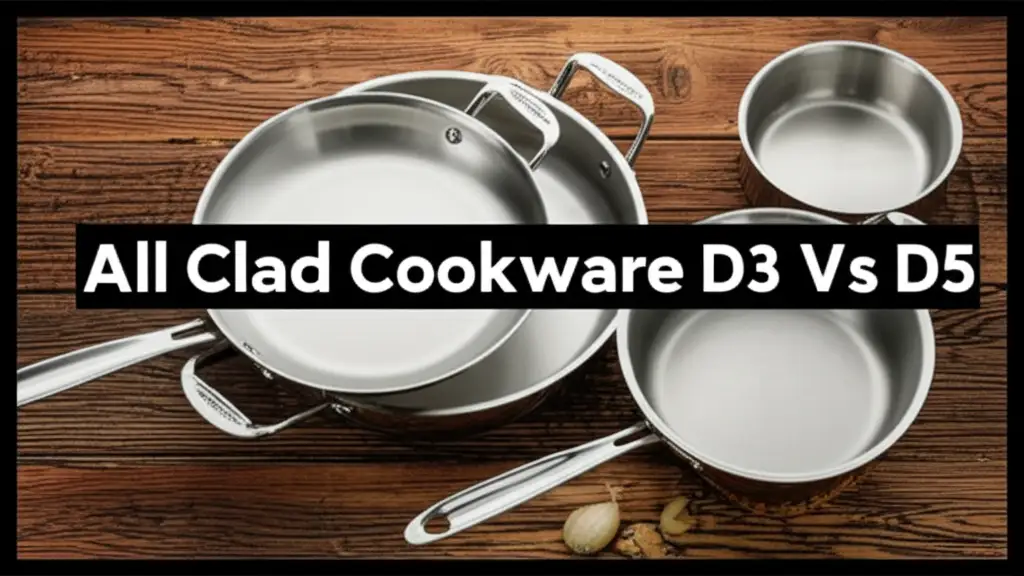· Elira Thomsen · Cookware · 21 min read
Aluminum Vs Enamel Cookware
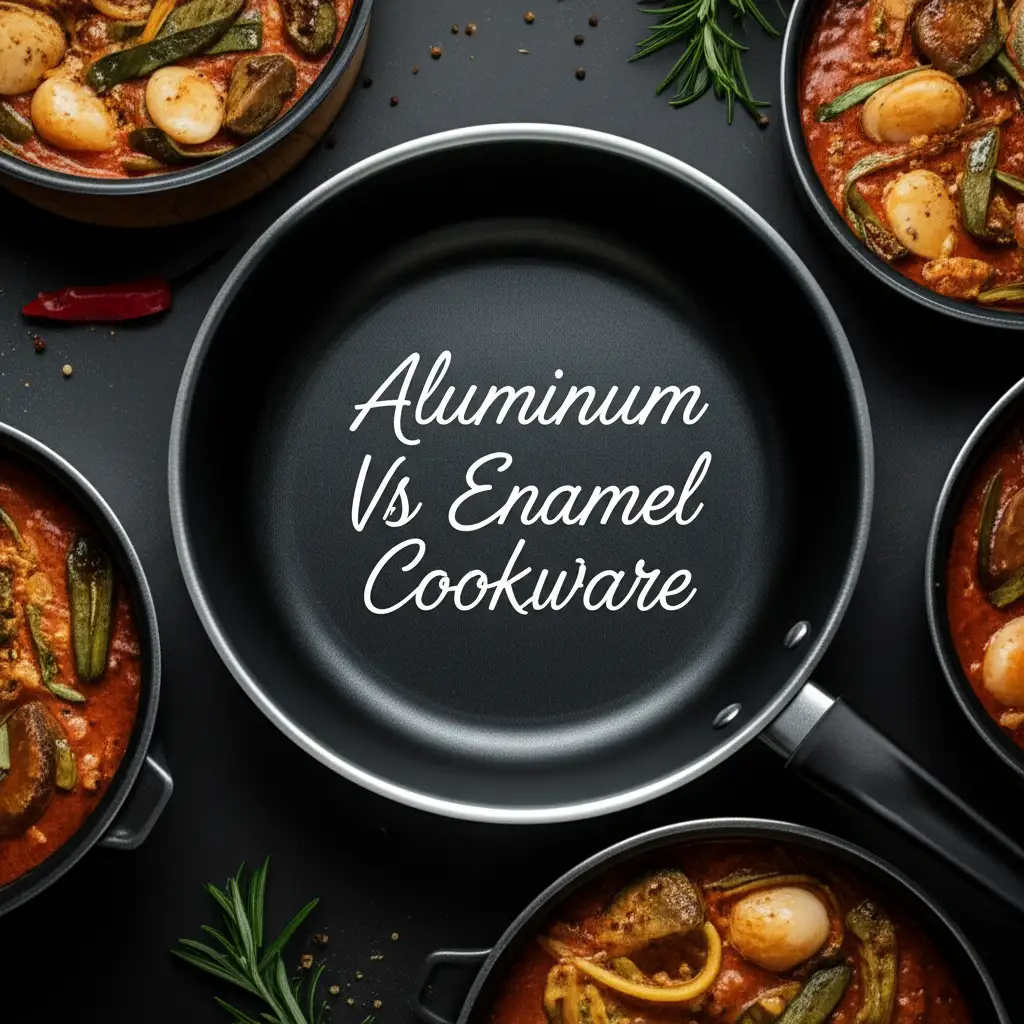
Aluminum vs Enamel Cookware: Choosing the Right Pots and Pans
Choosing new cookware can feel like a big decision. You want pieces that cook well and last long. Today, we look at two popular options: aluminum cookware and enamel cookware. Both have distinct features that suit different cooking styles and kitchen needs.
We will explore their differences in performance, safety, and care. This article helps you understand which type best fits your home. I will share insights on heat conductivity, durability, and maintenance. By the end, you will feel confident choosing the right pots and pans for your daily meals.
Takeaway
- Aluminum Cookware: Offers excellent heat conductivity and is lightweight. It often costs less than enamel.
- Enamel Cookware: Provides a non-reactive surface and even heat distribution. It is durable and adds style to kitchens.
- Heat Distribution: Aluminum heats quickly, while enamel offers more consistent, slower heat.
- Durability: Both are durable, but enamel can chip. Aluminum can dent.
- Safety: Bare aluminum reacts with acidic foods. Enamel coatings are generally non-reactive and safe.
- Cleaning: Enamel is easier to clean due to its smooth surface. Aluminum may need specific care to prevent discoloration.
Which is better: Aluminum vs Enamel Cookware?
Neither aluminum nor enamel cookware is universally “better.” Aluminum excels in quick, even heating and lightness. Enamel offers a non-reactive, easy-to-clean surface and consistent heat retention. The best choice depends on your specific cooking habits and priorities.
Understanding Aluminum Cookware
Aluminum is a very common material in kitchens. It heats up fast and spreads heat evenly. This makes it a favorite for many home cooks. My first set of pots included several aluminum pieces because they were affordable and functional.
Aluminum cookware is lightweight, making it easy to handle. Chefs often use it for quick-cooking tasks. It responds quickly to temperature changes, giving you good control over your cooking. We find this especially useful for sauces or stir-fries that need precise heat.
Benefits of Aluminum Cookware
Aluminum offers several advantages that make it a popular choice. Its high thermal conductivity stands out. This means heat moves through it very efficiently. You can get your water boiling fast or sear meat quickly.
Another big plus is its cost. Aluminum cookware is typically more affordable than many other materials. This makes it a great option for people setting up a kitchen on a budget. I remember buying a full set without breaking the bank. It is also lightweight. This makes it easy to lift and move, even when full of food.
- Excellent Heat Conductor: It heats up quickly and distributes heat evenly across the surface. This prevents hot spots that can burn food.
- Lightweight: Easy to lift, carry, and maneuver around the kitchen. This is a benefit for daily cooking.
- Affordable: Generally costs less than other cookware types. This makes it accessible for everyone.
Drawbacks of Aluminum Cookware
While aluminum has many good points, it also has some downsides. Bare aluminum can react with certain foods. Acidic ingredients like tomatoes or lemon juice can cause discoloration. They may also absorb small amounts of aluminum, changing the food’s taste.
Aluminum cookware is also softer than other metals. It can dent or scratch more easily. Using metal utensils on it can leave marks. I once accidentally scraped a new pan with a fork, which was frustrating. Another issue is that bare aluminum is not naturally non-stick. Food can stick without proper seasoning or a non-stick coating.
- Reactive to Acidic Foods: Bare aluminum can leach into food, altering flavor and potentially causing health concerns for some.
- Prone to Denting and Scratching: It is a softer metal, so it can deform or show signs of wear faster than harder materials.
- Not Naturally Non-Stick: Requires more oil or fat during cooking, or a special coating, to prevent food from sticking.
Exploring Enamel Cookware
Enamel cookware combines metal with a glass-like coating. This coating, made of porcelain enamel, covers a base material. Often, the base is cast iron or steel. This creates a smooth, non-reactive surface. I find enamel cookware very attractive, and it comes in many colors.
The enamel layer protects the base metal. It also provides a cooking surface that is easy to clean. This type of cookware is famous for its durability and even heating. It holds heat well, which is great for slow cooking or braising.
The Composition of Enamel Cookware
Enamel cookware starts with a core material. This core is usually cast iron or carbon steel. Cast iron offers excellent heat retention and distribution. Carbon steel makes the cookware lighter and heats up faster. The choice of core material impacts the cookware’s weight and heating properties.
A layer of porcelain enamel covers this core. Manufacturers fuse this glass-like coating onto the metal at very high temperatures. This process creates a strong, non-porous surface. The enamel coating prevents the core metal from reacting with food. It also makes the surface naturally resistant to sticking, though not completely non-stick like specialized coatings.
- Core Material: Typically cast iron for heavy, even heating, or carbon steel for lighter options.
- Porcelain Enamel Coating: A glass-based material fused to the core, providing a non-reactive and durable surface.
- Non-Porous Surface: The smooth enamel layer prevents food from sticking and makes cleaning simple.
Advantages of Enamel Cookware
Enamel cookware brings many benefits to the kitchen. Its non-reactive surface is a major plus. You can cook acidic foods like tomato sauces without worry. The enamel will not leach chemicals or alter food taste. This is a big win for healthy cooking.
It also provides excellent heat retention. Cast iron enamel, for example, holds heat for a long time. This makes it perfect for simmering stews or baking bread. It also looks beautiful. Enamel cookware comes in many colors, adding a decorative touch to your kitchen. My own enameled Dutch oven is a piece I display proudly.
- Non-Reactive Surface: Safely cooks acidic foods without leaching chemicals or changing flavor.
- Excellent Heat Retention: Especially true for cast iron enamel, it keeps food warm for longer periods.
- Attractive Design: Available in a wide range of colors, making it suitable for oven-to-table serving.
- Easy to Clean: The smooth, glass-like surface prevents food from sticking. This makes cleanup quick and simple.
Disadvantages of Enamel Cookware
Despite its benefits, enamel cookware has some drawbacks. The most significant is its susceptibility to chipping. If you drop it or hit it hard, the enamel can crack or chip off. Once chipped, the exposed metal underneath can rust, especially if it is cast iron. This also makes the cookware unsafe for use.
Enamel cookware, especially cast iron enamel, is often very heavy. This can be difficult to lift, especially when full. My large Dutch oven is quite a workout to move. It also takes longer to heat up than aluminum. While it retains heat well, getting it to temperature needs patience.
- Prone to Chipping: The enamel coating can chip if dropped or struck hard. Chipping exposes the base metal, leading to rust.
- Heavy Weight: Cast iron enamel versions are very heavy, making them harder to handle for some users.
- Slower to Heat Up: It takes longer to reach desired cooking temperatures compared to aluminum.
Heat Conductivity and Distribution
When we talk about cooking, how well heat moves through your pan matters a lot. This is where aluminum and enamel cookware show clear differences. Understanding these differences helps you choose the right tool for your cooking tasks. Both materials have unique ways of handling heat.
I always think about what I am cooking before picking a pan. A quick sear needs different heat properties than a slow simmer. The way your pan conducts and distributes heat directly impacts your food’s texture and taste. Let us break down how each material performs.
Aluminum: Rapid and Even Heating
Aluminum is a champion of heat conductivity. It transfers heat very quickly from the burner to your food. This means your pan warms up fast. It also spreads heat very evenly across its surface. You rarely find hot spots in a good aluminum pan.
This rapid, even heating is excellent for many cooking methods. Think about frying eggs, searing vegetables, or making pancakes. The entire surface gets hot at the same rate. This helps food cook uniformly. For quick meals, aluminum pans save time. They react quickly when you adjust the heat, giving you precise control. I love them for stir-fries where speed matters. Choosing a pan is a bit like choosing other kitchen tools; you pick what fits the job best, just like deciding between a Breville juicer vs Ninja blender based on what you need to make.
Enamel: Consistent and Retained Heat
Enamel cookware, especially cast iron enamel, behaves differently. It takes longer to heat up. However, once it reaches temperature, it holds that heat incredibly well. This makes it perfect for dishes that need long, slow cooking. Think about stews, braises, or soups.
The heat distribution is also very even. While slower to get there, the heat spreads gently. This prevents scorching and promotes tender results. It radiates heat, cooking food uniformly over time. This also means you can often cook on lower heat settings. This saves energy. For example, a Ninja cold press juicer pro vs Omega also involves understanding their different mechanisms for juicing. It’s all about matching the tool to the task.
- Aluminum: Heats up very fast, distributes heat quickly and evenly. Ideal for searing, frying, and quick cooking.
- Enamel: Heats up slowly but retains heat exceptionally well. Perfect for slow cooking, braising, and dishes needing consistent, gentle heat.
Durability and Lifespan
When you invest in cookware, you want it to last. Both aluminum and enamel cookware are durable, but they face different challenges. Their lifespan depends heavily on how you use and care for them. I have seen both types of pans last for decades with good treatment.
Understanding their strengths and weaknesses helps you protect your investment. A pan that withstands daily use is a valuable asset in any kitchen. Let us look at what makes each material last.
Aluminum Cookware: Resilience to Dents
Aluminum cookware is generally tough. It resists corrosion well, especially anodized aluminum. It is less likely to shatter or chip compared to enamel. However, aluminum is a softer metal. This means it can dent or scratch.
A dropped aluminum pan might get a ding. Metal utensils can leave marks on the cooking surface. Despite this, aluminum pans can handle a lot of daily use. They often maintain their cooking performance even with minor cosmetic damage. My older aluminum pans have some dents, but they still cook beautifully. Proper care, like using wooden or silicone utensils, helps extend their life.
Enamel Cookware: The Chip Factor
Enamel cookware is very durable when it comes to heat and non-reactivity. The porcelain enamel coating is strong. It resists scratches from normal cooking use. However, its main vulnerability is impact.
A hard drop or a sharp knock can cause the enamel to chip or crack. Once the enamel chips, the underlying metal is exposed. If the core is cast iron, it can rust. This rust can then spread and make the cookware unusable. You need to handle enamel cookware with care. Avoid dropping it and do not use metal utensils that might scratch or chip the surface.
- Aluminum: Resists corrosion and shattering. Prone to dents and scratches due to its softer nature.
- Enamel: Resists scratches on its surface but is highly susceptible to chipping if dropped or hit hard.
Safety and Health Considerations
When cooking for yourself or your family, safety is always a top concern. We all want to use materials that are healthy and do not react with our food. Both aluminum and enamel cookware have safety aspects to consider. Knowing these details helps you make informed choices.
I always think about what I am preparing and how the pan might interact with it. Certain foods can highlight the differences in material properties. Let us explore the health and safety features of each type of cookware.
Bare Aluminum Reactivity
Bare aluminum can react with acidic and alkaline foods. This means ingredients like tomatoes, citrus fruits, vinegar, or even baking soda can cause a reaction. During this reaction, small amounts of aluminum can leach into your food. This can sometimes give food a metallic taste. For some people, there are concerns about consuming excess aluminum, though research on its direct health impact from cookware is ongoing and generally considers it low risk for healthy individuals.
To avoid this, many aluminum pans are anodized or coated. Anodized aluminum has a harder, non-reactive surface. Coated aluminum, often with a non-stick layer, also prevents direct food contact. When choosing aluminum, consider if it has a protective layer. Using bare aluminum for quick cooking is fine, but avoid long simmering of acidic dishes. This is similar to how different knife sizes serve different purposes; you choose based on the task, like an 8 vs 10 inch chef knife.
Enamel’s Non-Reactive Surface
Enamel cookware is renowned for its non-reactive surface. The glass-like enamel coating creates a barrier. This barrier separates your food from the underlying metal, whether it is cast iron or steel. You can cook any type of food in enamel cookware without worrying about metallic tastes or chemical leaching.
This makes enamel a safe choice for all kinds of recipes, including highly acidic sauces and dishes. The enamel is inert, meaning it does not interact with food ingredients. As long as the enamel is intact and not chipped, it provides a very safe cooking surface. This non-reactivity is a major advantage for health-conscious cooks.
- Aluminum: Bare aluminum can react with acidic/alkaline foods, potentially leaching small amounts of aluminum into food. Anodized or coated aluminum mitigates this.
- Enamel: The porcelain enamel coating is non-reactive, safe for all food types, and does not leach chemicals into food as long as it remains intact.
Cleaning and Maintenance
Keeping your cookware clean is essential for hygiene and extending its life. Aluminum and enamel cookware have different cleaning needs. Knowing how to properly care for each type will save you time and effort. It also ensures your pans stay in good condition for years.
I have learned that proper cleaning is just as important as proper cooking. Neglecting care can shorten the lifespan of even the most durable pan. Let us look at the best ways to clean and maintain these two popular cookware types.
Caring for Aluminum Cookware
Cleaning aluminum cookware depends on whether it is bare, anodized, or coated. Bare aluminum can sometimes stain or discolor, especially with hard water or acidic foods. For daily cleaning, warm soapy water and a soft sponge work best. Avoid abrasive scrubbers or harsh detergents, as they can scratch the surface.
For stubborn stains on bare aluminum, a mixture of cream of tartar and water can help restore shine. Anodized aluminum is harder and more resistant to stains, making it easier to clean. Non-stick coated aluminum requires gentle cleaning to protect the coating. Always use non-abrasive tools. Over time, metal utensils can damage coatings, just as using the wrong settings on an air fryer can impact results, similar to the difference between Air Fryer 400 vs 450.
- Daily Cleaning: Use warm, soapy water and a soft sponge.
- Stains: For bare aluminum, a cream of tartar paste can remove discoloration.
- Avoid: Abrasive cleaners, steel wool, or harsh chemicals.
- Utensils: Prefer wood, silicone, or plastic to prevent scratches, especially on coated aluminum.
Maintaining Enamel Cookware
Enamel cookware is generally very easy to clean. Its smooth, non-porous surface resists food sticking. For everyday cleaning, warm soapy water and a soft cloth or sponge are usually enough. Food slides off easily. For baked-on food, you can fill the pan with water and a little dish soap. Let it simmer for a few minutes. This loosens the residue.
Avoid using metal scourers or harsh abrasive cleaners. These can scratch or chip the enamel surface. Wooden or silicone utensils are best to prevent damage during cooking. If the enamel chips, it is difficult to repair. Always let hot enamel cookware cool down before washing it. Sudden temperature changes can cause thermal shock and crack the enamel.
- Daily Cleaning: Warm soapy water and a soft cloth or sponge work well.
- Stubborn Food: Simmer water and dish soap in the pan to loosen stuck-on food.
- Avoid: Metal scrubbers, abrasive cleaners, or sudden temperature changes.
- Utensils: Use wood, silicone, or nylon to protect the enamel surface.
Versatility and Practical Uses
Cookware versatility defines how many different dishes you can make with one piece. Both aluminum and enamel cookware offer good versatility. However, their strengths lie in different cooking methods. Understanding these strengths helps you maximize their use in your kitchen.
I often think about my cooking style when choosing what pans to use. A quick weeknight dinner might call for one type, while a weekend project might call for another. Let us dive into the practical applications of each material.
Aluminum: The Quick Cook’s Friend
Aluminum cookware excels at tasks requiring quick and even heat. It is perfect for searing meats, sautéing vegetables, and frying eggs. Its lightweight nature makes it easy to toss ingredients or move the pan around. Many professional kitchens use aluminum for these fast-paced tasks.
Because it heats and cools rapidly, aluminum gives you excellent control over temperature. This is crucial for delicate sauces or precise browning. If you enjoy stir-frying or making pancakes, aluminum is a fantastic choice. It handles high heat well for quick-cooking methods. This speed and efficiency are key, similar to how an air fryer vs air roast offers different benefits for cooking time.
- Searing and Frying: Heats quickly to create a crisp crust on meats and vegetables.
- Sautéing: Even heat allows for uniform cooking of ingredients.
- Stir-Frying: Responsive to temperature changes, perfect for high-heat, quick cooking.
- Lightweight Handling: Easy to lift and maneuver, ideal for dynamic cooking.
Enamel: The Slow Cooker’s Delight
Enamel cookware shines in low and slow cooking methods. Its excellent heat retention makes it ideal for braising, simmering, and baking. Dishes like stews, pot roasts, and homemade bread benefit greatly from its consistent, gentle heat. The heavy lid of an enameled Dutch oven creates a self-basting environment, keeping food moist and flavorful.
Its non-reactive surface means you can cook acidic foods for hours without worry. This versatility extends to oven use; many enamel pieces are oven-safe up to high temperatures. They also double as beautiful serving dishes. I often bring my enameled Dutch oven straight from the stove to the table. This versatility is like choosing between different kitchen tools, such as an Air Fry Oven vs Air Fryer – each has its specific optimal uses.
- Braising and Stewing: Holds heat consistently for tenderizing tough cuts of meat and simmering rich flavors.
- Baking: Excellent for breads and casseroles, providing even heat for uniform baking.
- Oven-Safe: Most enamel cookware handles high oven temperatures, allowing for stove-to-oven cooking.
- Serving: Its attractive appearance makes it suitable for direct table serving.
Cost Comparison
Price is a significant factor for most people buying cookware. The initial cost can vary greatly between aluminum and enamel options. Understanding these differences helps you budget effectively. It also helps you decide where to invest more or save money.
I always consider the value for money. Sometimes paying a little more upfront saves you in the long run. Other times, a more affordable option performs perfectly well. Let us break down the typical costs.
Aluminum Cookware: Budget-Friendly Options
Aluminum cookware generally offers a more budget-friendly entry point. Bare aluminum pots and pans are often the least expensive. They are widely available and can be found at various price points. This makes them a popular choice for new cooks or those outfitting a first kitchen.
Even higher-quality aluminum, like hard-anodized or those with advanced non-stick coatings, tend to be more affordable than premium enamel. You can often buy a complete set of good aluminum cookware for less than a single piece of high-end enamelware. This cost-effectiveness is a major selling point. It allows access to functional cookware without a large financial commitment.
Enamel Cookware: A Premium Investment
Enamel cookware, especially enameled cast iron, typically comes with a higher price tag. Brands like Le Creuset or Staub are known for their quality and durability, but they are an investment. The manufacturing process for enamel, particularly the multi-layer coating and firing, adds to the cost.
While the initial outlay is higher, many users see it as a long-term investment. With proper care, enamel cast iron can last for decades, even generations. Its durability and versatility can justify the cost over time. However, if budget is your main concern, enamel cookware might be a stretch. It is a decision about value versus upfront cost, much like considering the air fryer electricity usage vs oven for long-term savings.
- Aluminum: Generally more affordable, offering excellent value for daily cooking needs.
- Enamel: Typically a higher upfront investment, especially enameled cast iron, but offers long-term durability and performance.
Environmental and Sustainability Aspects
Considering the environmental impact of our purchases is growing in importance. Cookware production involves resource extraction and manufacturing processes. Disposal also plays a role. Both aluminum and enamel cookware have different environmental profiles. I try to make choices that align with sustainable practices whenever possible.
Understanding the lifecycle of these materials helps us make more responsible choices. From production to end-of-life, each material has distinct implications. Let us look at their environmental considerations.
Aluminum: Recyclability and Energy Use
Aluminum is highly recyclable. It is one of the most recycled materials globally. Recycling aluminum uses significantly less energy than producing new aluminum from raw ore. This makes aluminum cookware a more environmentally friendly choice at its end of life, provided it is properly recycled.
However, the initial production of aluminum is very energy-intensive. Extracting bauxite ore and processing it into aluminum uses a lot of electricity. This contributes to greenhouse gas emissions. When choosing aluminum, look for products made from recycled content. This reduces the overall environmental footprint. The durability of aluminum cookware also means it does not need frequent replacement. This further reduces waste.
- Recyclability: Highly recyclable, saving significant energy compared to new production.
- Production Energy: Initial production is energy-intensive, with a notable carbon footprint.
- Durability: Long lifespan reduces frequent replacement, lowering overall waste.
Enamel: Durability and Material Sourcing
Enamel cookware, particularly cast iron enamel, is prized for its extreme durability. A well-maintained piece can last a lifetime, or even be passed down through generations. This longevity significantly reduces the need for replacement. This makes it a sustainable choice from a lifespan perspective. Less frequent buying means less waste.
The core material, cast iron, comes from iron ore. This is an abundant natural resource. The enamel coating is essentially glass, made from natural minerals. While the manufacturing process involves high temperatures, the product’s long lifespan balances this out. However, enamelware is generally not easily recyclable in standard recycling programs due to its composite nature (metal fused with glass). This means careful disposal or donation is important at its end of life.
- Longevity: Exceptional lifespan reduces consumption and waste over time.
- Material Sourcing: Core materials like iron are abundant. Enamel uses natural minerals.
- Recyclability Challenges: Composite nature makes it difficult to recycle through conventional methods.
FAQ Section
Is aluminum cookware safe for daily cooking?
Yes, aluminum cookware is generally safe for daily cooking. Modern aluminum pans are often anodized or coated to prevent food reactivity. Bare aluminum may react with highly acidic foods, potentially leaching small amounts of metal or altering taste. For general use, it poses a low health risk for most people.
Can enamel cookware go in the dishwasher?
Most enamel cookware is safe for dishwashers, but hand washing is recommended. The harsh detergents and high heat in dishwashers can dull the enamel finish over time. They might also lead to chipping if pieces bang together. Hand washing extends the lifespan and maintains the beauty of your enamelware.
Does aluminum cookware scratch easily?
Yes, bare aluminum cookware can scratch more easily than harder metals. It is a softer material. Using metal utensils can leave marks. Hard-anodized aluminum is more scratch-resistant. Using wooden, silicone, or nylon utensils helps protect the surface of all aluminum types.
What is the best way to prevent enamel from chipping?
To prevent enamel from chipping, handle the cookware with care. Avoid dropping it or hitting it against hard surfaces. Use wooden or silicone utensils instead of metal ones during cooking. Store it carefully, placing soft cloths between pieces if stacking. Also, avoid extreme temperature changes.
Is enamel cookware good for high heat cooking?
Enamel cookware can handle high heat, especially enameled cast iron. However, it takes longer to heat up. It retains heat very well once hot. It is excellent for searing or achieving a good crust. Always preheat gradually. Overheating can cause food to stick.
How does aluminum compare to stainless steel in cookware?
Aluminum heats faster and more evenly than stainless steel. Stainless steel is more durable, non-reactive, and resistant to scratching. Many high-quality pans combine these by using an aluminum core clad with stainless steel. This offers the benefits of both materials.
Conclusion
Choosing between aluminum vs enamel cookware depends on your cooking style and priorities. Aluminum offers rapid, even heating and is lightweight. It is often more budget-friendly. However, bare aluminum can react with acidic foods, and it might dent or scratch more easily. It is excellent for quick tasks and general daily use, especially if it is anodized or coated.
Enamel cookware, particularly enameled cast iron, provides a non-reactive, easy-to-clean surface. It excels at slow, even cooking and exceptional heat retention. It is also quite beautiful. The main downsides are its weight and susceptibility to chipping. It represents a premium investment but offers long-term durability and versatile cooking.
I hope this guide helps you make the best choice for your kitchen. Consider what you cook most often. Think about your budget and how much care you want to give your pans. Both aluminum and enamel cookware bring unique benefits to the table. Make your next meal with the perfect tools.
- aluminum cookware
- enamel cookware
- kitchen essentials
- cooking tips
- cookware comparison
- durable cookware
- non-toxic cookware


